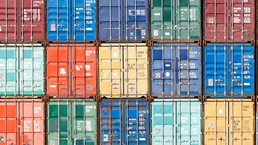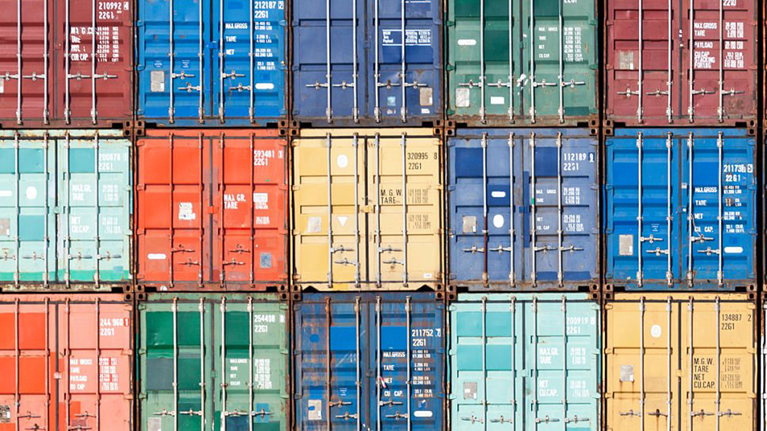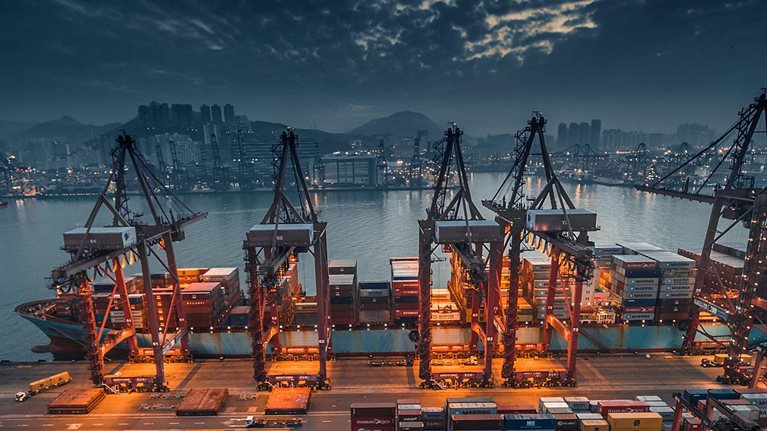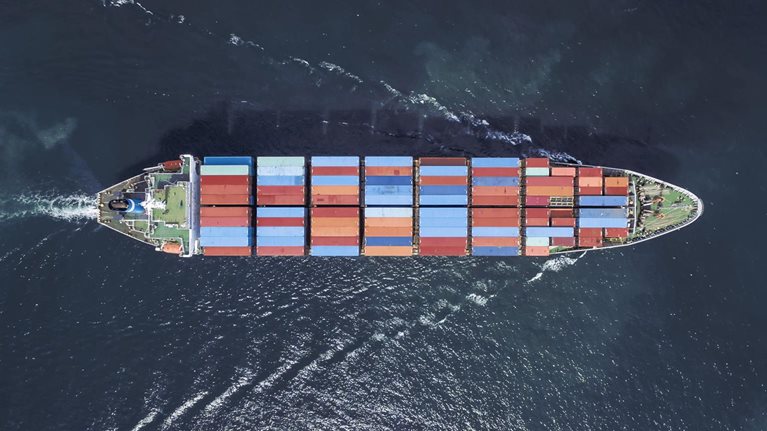Imagine you’re a cargo owner in the year 1450. You hand over your goods to the ship that will carry them across the world, and are presented with a bill of lading—a piece of paper stating what you’re shipping, where it comes from, and where it’s heading.
Fast forward to the year 2022: The world has changed dramatically, but the bill of lading remains relatively unchanged. Today, the bill of lading process is still reliant on the physical transfer of paper records and applies to roughly 40 percent of all containerized trade transactions.1
Current trade documentation spans many documents and processes, and is a manual, time-consuming, and resource-intensive process for all stakeholders. Documentation for a single shipment can require up to 50 sheets of paper that are exchanged with up to 30 different stakeholders.2 The bill of lading, issued by carriers to acknowledge receipt of cargo from the shipper, is one of the most important trade documents required for shipping. McKinsey analysis indicates that the bill of lading accounts for between 10 and 30 percent of total trade documentation costs.3 While the banking and aviation industries have implemented digital standards enabling automated trade systems, shipping has not matured far beyond where it was in the 1400s.
Digitalizing trade documentation is an important step that can avoid unnecessary cost, save time, and enable trade. It can also improve supply-chain resilience and help to mitigate inevitable future disruptions. Today’s renewed focus on supply-chain performance and resiliency provides an opportune time for the ocean trade ecosystem to unite and embrace digitalization.
This article builds a case for digitalizing trade documentation and demonstrates how adopting an electronic bill of lading could save $6.5 billion in direct costs and enable between $30 billion and $40 billion in new global trade volume. It also highlights actions that various stakeholders can take to unlock this opportunity in global ocean shipping.
Disruption is inevitable; digitalization can build supply-chain resilience
Recent global challenges made supply-chain resilience an imperative for businesses across the world. The COVID-19 crisis, post-pandemic economic effects, and geopolitical conflicts resulted in critical supply snarls all over the globe. These events, and the disruptions that followed, revealed how important, yet fragile, trade flows are for the global economy.
In today’s environment, supply-chain disruption is constant and impactful. It is no longer an “if”, nor is it really a “when” since it’s both omnipresent and unpredictable at the same time.4 Research by the McKinsey Global Institute found that, on average, companies experience disruption of supply inflows lasting one to two months every 3.7 years—and shorter disruptions happen even more frequently. Furthermore, a single prolonged production-only shock could wipe out between 30 and 50 percent of one year’s EBITDA for companies in most industries—an event that disrupts distribution channels as well would push the losses sharply higher for some. An event that disrupts distribution channels as well would push the losses sharply higher for some.5
Considering that disruption is inevitable, increasing resilience to mitigate the effects of disruption on supply chains has become one of the major challenges of the decade. One way to improve supply-chain resiliency is for industry leaders to focus on elements that can be controlled—rather than attempting to prevent events that cannot be controlled.
For example, when the Icelandic Eyjafjallajökull volcano erupted in 2010, 100,000 flights were cancelled, affecting passengers as well as air cargo, and thus supply chains.6 Cargo worth an estimated value of $50 billion was substantially delayed in reaching destinations.7 Leaders could not prepare for this event and were instead measured by their ability to react. Supply chains elongated as airborne trade was rerouted around Icelandic airspace, and companies had to quickly identify and book capacity in unfamiliar trade lanes. An outcome of this event was that industry leaders learned that their ability to respond to disruption was directly tied to their ability to share information and transact with their supply-chain partners as quickly and efficiently as possible.
Although the COVID-19 pandemic was first and foremost a humanitarian crisis, the supply-chain disruption it caused has many similarities to the Eyjafjallajökull example. Over the past two and a half years, thousands of containers with missing or incorrect documentation lingered in ports as flights transporting the physical trade documents for these containers were canceled. Without verified documentation, the marine terminal operators and customs authorities could not release the cargo, which exacerbated congestion. This situation resulted in lost sales and higher working capital costs for shippers—and eventually to total loss of value, in the case of seasonal merchandise missing its delivery date. These complications may have been avoided through transparent and accessible digital documentation. And some disruption could have been avoided if physical offices had been quick to adopt remote working processes for trade documentation.
The trade financing market was also affected during the pandemic. Rejected applications for trade credit insurance increased by 60 percent, forcing governments to utilize their export credit agencies to fill financing gaps left by the private market.8 The Export-Import Bank of the United States (EXIM), one of the largest providers of short-term government export support, reported a 112 percent increase in working capital guarantees and a 12 percent increase in short-term export credit insurance during the 2020 fiscal year.9
During this period, greater levels of digitalization could have helped government export credit agencies to accelerate communication with trade insurance applicants. The faster and more efficient exchange of documents may have allowed government institutions to fill the trade finance gaps left by the private market much earlier.
Would you like to learn more about our Travel, Logistics & Infrastructure Practice?
It’s time to reshape outdated global trade standards
These recent events have made it apparent that information sharing, collaboration, and greater visibility can build resilience to disruption. Digitalization plays a key role in building resilience as it enables the flow of information. However, 30 years after the “go-live” of the internet, and 25 years after purely digital cross-border ecommerce processes were established, trade documentation processes are still largely manual.
For example, many bills of lading are still reliant on the physical transfer of paper records—and the documentation process alone can take six hours, or more, across all stakeholders. Furthermore, other important trade documents, like letters of credit and customs declarations, require the paper-based bill of lading as a prerequisite for their creation and issuance.
The original bill of lading still requires many stakeholders to print, stamp, and sign various paper copies before physically transporting them from origin to destination as air express shipments (Exhibit 1). This non-digital process is costly, takes time to execute, and is highly susceptible to errors.

While other industries have captured the impact of digitalized documentation, shipping is only beginning to make progress
The banking industry represents a reasonable comparison for shipping: It is an industry that depends upon documentation and data exchange between various stakeholders, and requires that transmission of this data maintains its accuracy and confidentiality. The banking industry has successfully digitalized many documentation processes by establishing SWIFT, an information exchange system using universally valid, and fixed standards for secure transactions.
Shipping carriers have historically focused more on the physical utilization of assets (ships), rather than on the efficient exchange of information between stakeholders. The small margins and low returns on capital within the industry may have prevented carriers from thinking beyond containers and contribution margin.
Digitalization of the bill of lading has been slow and difficult to date, as various stakeholders are involved in the process, all of whom have different interests, needs, and systems—and must be approached individually. In addition, many other documents are connected to the bill of lading process via a multitude of interfaces, so that individual digitalization initiatives may have been dismissed as unattractive due the limited impact that a single stakeholder can make on its own. The bill of lading also requires acceptance of regulators globally and may seem too big to address by a single private entity. Furthermore, the bill of lading is a document of title and therefore requires the highest possible security standards, over and above e-mail or electronic data interchange (EDI) standards, and this creates additional concerns for all parties involved. The shipping industry has started to work on common standards for digital documents as the banking industry has done.
During the COVID-19 pandemic, paper-based processes may have added to the stresses that impacted global supply chains. However, the recent attention paid to ocean supply chains has spurred progress, and the container shipping industry is now working to resolve digitalization roadblocks. The shipping ecosystem has experienced increased consolidation and record-high profitability, enabling carriers to invest in ambitious digital agendas. Carriers seeking to get closer to their customers have made digital interfaces a strategic priority for growth.
Shipping is also experiencing a renewed focus on industry collaboration. Stakeholders are collaborating in a variety of collective action forums including the Getting to Zero Coalition, Mærsk Mc-Kinney Møller Center for Zero Carbon Shipping, TradeLens, and the Global Shipping Business Network. These industry bodies are accelerating the alignment required to set industry goals such as sustainability and digitalization targets.
Digitalization has also been bolstered by organizations actively setting and promoting digital change. For example, the Digital Container Shipping Association (DCSA), a collaboration between several large container shipping companies, has helped the industry to establish digital standards for critical building blocks of information exchange, like electronic bills of lading and vessel schedules.
Trade digitalization is a multi-billion-dollar opportunity
The digitalization of trade documentation may be considered to be a mundane task, but the impact it could deliver would be significant. Various international bodies have estimated the effect that digitalization would have on global trade. The International Chamber of Commerce (ICC) projects that paperless trade could create $267 billion of additional exports across G7 countries, compared to base forecasts, by 2026.10 And the World Trade Organization reports that implementing the Trade Facilitation Agreement (TFA) could increase global trade by between $750 billion and $1 trillion a year.11 The TFA aims to reduce the trade costs of import and export activities and accelerate the clearance of goods by setting digitalization standards such as electronic data submission between agencies and the use of digital signatures. Implementing the TFA would likely produce wide-ranging economic benefits, especially in emerging and developing countries.
The ICC notes that the use of paper-based processes places an extraordinary burden on small and medium-sized enterprises (SMEs) seeking to trade internationally—and digitalization would help close this trade finance gap.12 According to the World Economic Forum, the current trade finance gap, or the amount of requested trade finance that is rejected, is estimated at $1.5 trillion globally, with SMEs suffering the most.13
Given this global context, the size and potential impact of the digitalization opportunity, and the importance of the bill of lading, McKinsey analyzed how an electronic bill of lading could add value. The analysis indicates that digitalizing the bill of lading—which accounts for 10 to 30 percent of trade documentation costs—could unlock more than $15.5 billion in direct benefit to the shipping ecosystem and up to $40 billion in increased trade.14
The analysis quantifies the expected impacts of 100 percent adoption of an electronic bill of lading on ocean carrier costs, for stakeholders in the broader shipping ecosystem, and on broader trade enablement. This quantification illustrates the substantial impact that can be generated from digitalizing a single, yet critical, component of trade documentation.
Adopting an electronic bill of lading could lead to direct cost savings for all stakeholders, amounting to $6.5 billion a year. Carriers could realize up to $2.1 billion in benefits such as more direct interaction with shippers, and streamlined and digitalized workloads, leading to cost savings. New digital capabilities could also lead to new revenue stream for carriers, for example through improved customer journeys. A further $6.9 billion in value could be unlocked for the broader trade ecosystem. Ultimately, greater digitalization could enable $40 billion in global trade by 2030 (Exhibit 2).

There is no better time than now to digitalize the bill of lading
Several factors indicate that the industry is ready to embark on digitalizing the bill of lading. First, digital standards for the bill of lading have been established. Data and process standards for the submission of shipping instructions and issuance of the bill of lading have already been established through DCSA, and accepted by nine container carriers that represent 70 percent of containerized trade.
Second, the required IT investment to accommodate a digital bill of lading is low. McKinsey estimates that limited investments into IT connectivity and employee training would enable this transition. These costs would be more than offset by the aforementioned cost savings.
Third, electronic bill of lading transactions already exist—and they work. Over the past 25 years several providers such as Bolero International and WAVE BL have established platforms to exchange electronic bills of lading. While around 1 percent of all bill of ladings are digital today, this adoption proves that the process has been tested and it works.15

Driving decarbonization: Accelerating zero-emission freight transport
The industry is capable of making the change
Evidence from frontrunning market participants, as well as digitalization journeys of other industries, shows that ocean trade can adopt digital trade documentation in 3 to 4 years, and reach 100 percent adoption by 2030. The industry is well positioned to make this change.
For instance, the airline industry and the International Air Transport Association (IATA) scaled the electronic airwaybill for cargo shipments—a digital process that is replacing paper-based trade documentation—from a small percentage in 2012 to more than 50 percent adoption in 2017.16
Lighthouse examples exist of market participants in ocean trade that are striving for change. ZIM International Shipping Lines has set ambitious targets for digitalizing trade documentation. The carrier started educating customers about the benefits of an electronic bill of lading and trained its workforce to get familiar with the new process. The effort yielded results very quickly: After one year, the carrier tripled its adoption rate of the electronic bill of lading from 3 percent to 10 percent.
Furthermore, frontrunner ports and their local governments including Singapore and Abu Dhabi have set the regulatory framework to treat digital documents just like paper-based documents.17 Other countries are about to follow suit, and the United Kingdom has already announced that digital trade documentation forms part of the government’s legislative agenda.18
A path forward: Unlocking potential through digitalization
There is an opportunity for stakeholders—including carriers, financial institutions, customs authorities, shippers, and freight forwarders—to work together to further trade digitalization efforts, and reap the benefits. Stakeholders could consider the following four actions that would facilitate industry-wide adoption of an electronic bill of lading and greater trade documentation digitalization (Exhibit 3).

1. Continue data standardization efforts
The complete end-to-end digitalization of container trade requires industry-wide standards for data structure and transmission. Stakeholders can build upon on existing standardization efforts, for instance by working with major players such as trade financiers and public authorities to contractually agree on a specific standard to make the transformation of the entire ecosystem as cost-effective and universally applicable as possible.
2. Set ambitious targets for digitalization
Various stakeholders can take action to set targets and associated KPIs:
- Carriers could activate internal change management programs to facilitate digitalization, supported by information and training campaigns. They could also form digitalization-dedicated teams to develop achievable road maps and KPIs, with actionable steps, and lead system integration projects.
- Banks and trade financing institutions could integrate the newly defined standards into existing systems and facilitate wide-spread adoption of a digital letter of credit solution.
- Customs authorities could accelerate digitalization that enables data receiving, for instance through a shipping application programming interface (API). They could also build road maps to enhance digital infrastructure, and prompt regulators to set guidelines that allow for digital document submission and transmission.
- Shippers and freight forwarders could increase their knowledge of new ways of working through training so that a smooth transition is guaranteed. They could also set milestones including tangible sub-targets, for example a fixed date for when a central supplier should be fully connected digitally in terms of trade documentation.
3. Collaborate with partners to accelerate the digitalization journey
All stakeholders can scale up current electronic bill of lading solutions and work together to keep existing infrastructure running, as collaboratively as possible. The industry can move to finalize electronic bill of lading solutions and API integrations to jointly shift to the new era of container shipping.
4. Accelerate acceptance by incentivizing stakeholders and customers
All relevant stakeholders could accept a defined approach, and commit to implementation, ideally guided by a neutral party. They could also enhance the interoperability of the electronic bill of lading with existing systems, simplify connectivity, and reduce barriers in terms of costs and time—especially for SMEs.
The time is ripe for all stakeholders across the global ocean trade ecosystem to join forces, work collaboratively to digitalize trade documentation, and usher in a digitalized “new normal.” Doing so could future-proof the industry, and shape a more inclusive global trade system. In particular, adopting an electronic bill of lading could result in significant cost savings and boost global trade.


